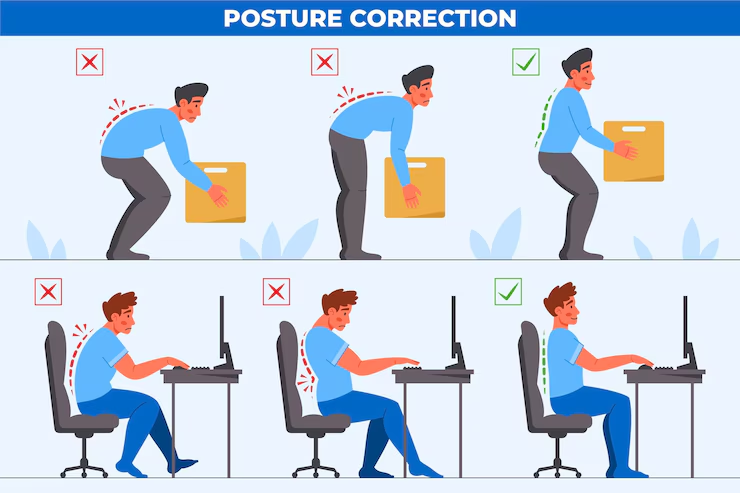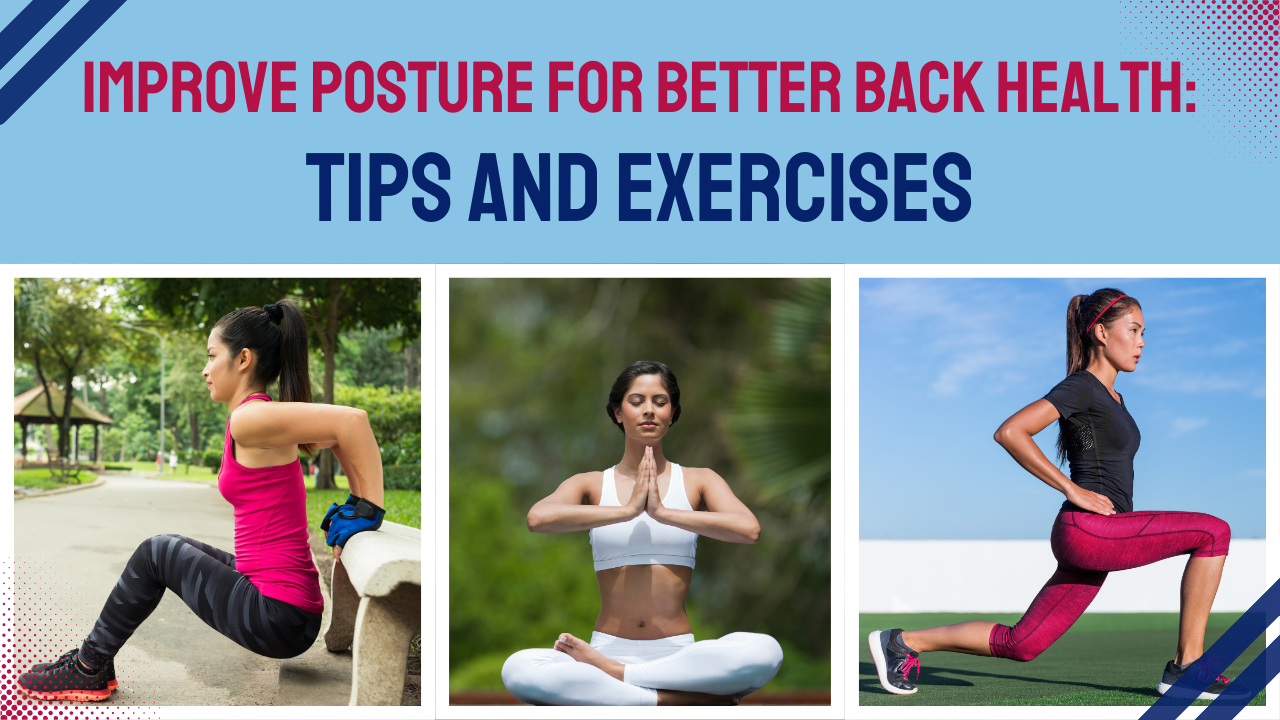Good posture is essential for maintaining overall health, especially when it comes to your back. A properly aligned spine reduces strain on muscles, ligaments, and joints, preventing discomfort and long-term spinal problems. Unfortunately, modern lifestyles, characterized by long periods of sitting, poor ergonomics, and sedentary habits, often lead to poor posture, which can harm your back health.
This article will highlight the significance of posture and the impact of poor posture on your back. It will also offer practical tips for improving posture to support your spine and prevent back pain. From simple exercises and stretches to ergonomic adjustments, you’ll learn effective strategies to maintain good posture and keep your back healthy.

Understanding Posture and Its Impact on the Body
Before diving into the ways to improve posture, it’s important to understand what posture is and why it matters for your back health.
What is Posture ?
Posture refers to the way your body is positioned while sitting, standing, or lying down. Proper posture keeps your body aligned, reducing strain on muscles, joints, and ligaments. This alignment helps prevent discomfort, pain, and long-term health issues. On the other hand, poor posture leads to imbalances in the body, which can cause strain and result in pain or injury over time. Maintaining good posture is essential for supporting overall health and preventing back and joint problems.
Why is Good Posture Important for Back Health ?
Your spine is built to support your body’s weight and maintain balance. When you practice proper posture, the pressure on your spine and muscles is evenly distributed, preventing strain. However, poor posture causes uneven pressure on specific areas of the back, leading to discomfort and pain. Over time, this misalignment can result in muscle fatigue and more serious issues, such as herniated discs or sciatica. Maintaining good posture is key to supporting your spine and reducing the risk of long-term back problems. Proper alignment helps keep your muscles and joints healthy and balanced.
How Poor Posture Affects Your Back Health
Poor posture not only affects your appearance but also harms your spinal health. Misalignment puts strain on your muscles, joints, and ligaments, leading to discomfort, pain, and long-term issues. Maintaining proper posture is crucial for supporting your spine and preventing potential back problems and injuries. Here’s how it happens:
- Excess Pressure on the Spine
Slouching or hunching over changes the natural curves of your spine, putting extra pressure on the discs between your vertebrae. This added pressure can lead to wear and tear on the spinal discs over time. As a result, you may experience chronic pain, particularly in the lower back and neck. Poor posture, if left unaddressed, can lead to long-term discomfort and potential spinal issues, making it important to maintain proper alignment to protect your back and neck.
- Muscle Strain and Fatigue

Misaligned posture causes certain muscles to work harder than others, leading to overuse and weakness. For example, slouching strains the lower back muscles and hip flexors, resulting in tension and discomfort. Over time, these muscles can become fatigued, causing chronic aches and pains. To prevent muscle strain, it’s essential to maintain proper posture and avoid positions that place excessive stress on specific muscle groups, ensuring balanced muscle activity and reducing the risk of discomfort.
- Decreased Mobility
Poor posture limits the natural movement of your spine, making it harder to move freely and comfortably. This restriction can lead to stiffness and a reduced range of motion in the back, affecting daily activities like bending, twisting, or even walking. Over time, decreased mobility can become a significant hindrance, making tasks more challenging and potentially leading to long-term discomfort or injury. Maintaining proper posture helps keep the spine flexible and supports smoother movement.
- Nerve Compression
Poor posture can lead to spinal misalignment, which may compress certain nerves, resulting in conditions like sciatica. This nerve compression can cause pain, numbness, or tingling sensations, often felt in the lower back, legs, or feet. If not corrected, nerve compression can worsen over time, leading to persistent discomfort or even long-term nerve damage. Keeping your posture aligned helps protect the spine and reduces the risk of nerve-related issues.
Signs of Poor Posture and How to Identify Them
Recognizing the signs of poor posture is the first step toward improving it. Some common indicators of poor posture include:
Slouching or Rounded Shoulders: This occurs when you sit or stand with your shoulders hunched forward, causing a misalignment in the upper back. It can lead to tension and discomfort over time, as the body is not positioned in its natural, balanced posture.
Forward Head Posture: This happens when your head juts forward, rather than aligning naturally with your spine. It places strain on the neck muscles and can lead to tension and discomfort in the neck and shoulders, affecting posture and causing potential long-term issues.

Lower Back Pain: Prolonged periods of sitting, especially without proper posture, can lead to discomfort or pain in the lower back. The spine is not properly supported, causing stress on the lower back muscles and joints, which can lead to chronic pain over time.
Neck or Shoulder Stiffness: Misalignment of the cervical spine (neck region) can cause stiffness and pain in the neck and shoulders. This stiffness may worsen with poor posture, as the spine and muscles are not properly aligned, leading to strain and discomfort.
Muscle Fatigue: When poor posture is maintained, certain muscles—especially in the back and shoulders—are overworked, leading to fatigue. These muscles are forced to work harder to keep the body upright, resulting in soreness, tiredness, and tension, which can contribute to ongoing discomfort.
How to Improve Your Posture: Simple Techniques for a Healthier Back
Improving your posture involves making mindful adjustments to the way you sit, stand, and move. Below are some practical steps you can take to correct poor posture and support your back health.

Mind Your Sitting Posture
Your sitting posture plays a crucial role in maintaining back health, especially if you spend extended hours sitting at a desk or working on a computer. To avoid strain, make sure to follow these guidelines: Sit all the way back in your chair so that your back is fully supported, with your feet flat on the floor and your knees at a 90-degree angle. Use a cushion or lumbar support to support your lower back and maintain the natural curve of your spine. Keep your computer screen at eye level to prevent leaning forward or tilting your head. Adjust your chair height so that your elbows form a 90-degree angle when typing or using a mouse, ensuring a comfortable position for your arms.
Stand Tall: The Power of Proper Standing Posture
Proper standing posture is just as important as sitting posture for avoiding strain on your back. When standing, follow these guidelines: Stand with your feet shoulder-width apart and distribute your weight evenly between both feet. Engage your core muscles to support your spine and keep your posture upright. Avoid locking your knees—keep them slightly bent to maintain alignment and prevent discomfort. Align your ears, shoulders, and hips in a straight line, and ensure your chin is parallel to the floor to avoid neck strain. This posture will reduce unnecessary stress on your back and promote balance.
Strengthen Your Core and Back Muscles
Building strength in your core and back muscles is essential for supporting proper posture and preventing slouching. A strong core stabilizes the spine, helping you maintain a neutral position throughout the day. Include core exercises like planks, bridges, and leg raises in your routine to target the abdominal and lower back muscles. For the upper back, incorporate exercises like Superman, reverse flys, and bird-dog to strengthen the muscles along your spine. These exercises improve spinal support and alignment, making it easier to maintain good posture and avoid discomfort.
Stretch and Improve Flexibility
Tight muscles, especially in the hips, hamstrings, and shoulders, can contribute to poor posture. Regular stretching helps relieve tension and improve flexibility, making it easier to maintain proper alignment. Focus on hip flexor stretches to release tightness from prolonged sitting. Chest stretches are essential for opening up the chest and counteracting the effects of rounded shoulders. Upper back stretches will help release tension in the shoulders and upper back, improving overall posture and flexibility. Incorporating these stretches into your daily routine can improve mobility and support better posture.
Mindful Movements: How to Avoid Postural Stress
Being mindful of how you move throughout the day is essential for preventing postural stress and maintaining proper alignment. Whether you’re lifting, walking, or sleeping, pay attention to your posture to avoid strain: When lifting, bend your knees, not your waist. Keep the object close to your body and use your legs to lift, rather than straining your back. While walking, maintain a straight back, relaxed shoulders, and a chin parallel to the ground to avoid hunching. When sleeping, use a pillow that supports the natural curve of your neck and spine, and avoid sleeping on your stomach to protect spinal alignment.
Posture Correction Exercises for a Stronger Back
These exercises can help correct posture imbalances and strengthen key muscles involved in maintaining good posture:
| Exercise Name | Targeted Muscle Group | Duration/ Reps |
|---|---|---|
| Cat-Cow Stretch | Spine, back, and shoulders | 10-15 reps |
| Chest Opener Stretch | Chest and shoulders | Hold for 15-30 seconds |
| Plank | Core, back, and shoulders | Hold for 30-60 seconds |
| Bridge | Glutes, lower back, core | 10-15 reps |
| Superman | Lower back and glutes | Hold for 15-30 seconds |
| Wall Angels | Shoulders, upper back | 10-12 reps |
These exercises, performed regularly, can help strengthen muscles that support proper posture and alleviate muscle imbalances that lead to discomfort.
Ergonomic Tips for Posture Improvement
Incorporating ergonomic principles into your workspace and daily routine is essential for improving posture and preventing back strain. Small adjustments can have a big impact on your comfort and overall health.
Desk Setup: Your desk should be at a height that allows your forearms to remain parallel to the floor when typing. This helps prevent shoulder and wrist strain. Additionally, ensure your computer screen is positioned at eye level, so you don’t have to tilt your head forward or strain your neck, reducing the risk of neck pain and stiffness.
Chair Choice: Select a chair that offers adequate lumbar support, which helps maintain the natural curve of your lower back. A chair that promotes a neutral spine position encourages proper alignment and reduces pressure on your spine, helping to avoid discomfort during long periods of sitting.
Take Breaks: Sitting for long periods can lead to stiffness and muscle fatigue. To prevent this, it’s important to take breaks every 30 minutes. Stand, stretch, or walk around to keep your muscles active and reduce the pressure on your spine. These breaks also help with circulation and mental clarity.
Use a Footrest: If your feet don’t reach the floor comfortably while sitting, a footrest can help achieve proper alignment. By keeping your feet flat and your knees at a 90-degree angle, a footrest ensures that your posture remains neutral and supports overall spinal health.
The Long-Term Benefits of Good Posture for Back Health
Maintaining good posture offers numerous long-term benefits for your back health, making it essential for both comfort and overall well-being.

Reduced Back Pain: Proper posture helps align the spine correctly, reducing the pressure placed on the vertebrae, muscles, and ligaments. This alignment prevents unnecessary strain, which in turn reduces the risk of developing chronic back pain. Over time, maintaining good posture can help avoid discomfort and support long-term spinal health.
Improved Mobility: A well-aligned spine allows for better movement and flexibility throughout the body. By supporting the natural curvature of your spine, proper posture enhances your range of motion, making it easier to bend, stretch, and move without stiffness or discomfort. This contributes to better functional mobility in daily activities.
Better Breathing: Maintaining correct posture opens up the chest area, allowing for better lung expansion. When the spine is aligned, the ribcage can expand more freely, improving lung capacity. This makes it easier to breathe deeply and efficiently, which can have positive effects on overall energy levels and oxygen intake.
Enhanced Confidence: Good posture not only improves your physical alignment but also boosts your mental state. Standing or sitting with proper posture can make you appear taller and more confident, which can enhance your self-esteem. Additionally, reducing the stress and discomfort caused by poor posture can lead to improved mental well-being, making you feel more relaxed and in control.
Conclusion
Improving your posture may take time and effort, but the benefits are definitely worth it. Small adjustments to your daily routine can make a big difference in reducing back pain and preventing long-term problems. By being mindful of how you sit, stand, and move, you can support your spine and enhance your overall health.
Including posture-correcting exercises into your routine is an excellent way to strengthen the muscles that support your back. Regular stretching and strengthening exercises help maintain spinal alignment and improve flexibility, reducing the risk of discomfort or injury.
Additionally, paying attention to ergonomics in your workspace can prevent strain on your back. Make sure your desk setup, chair, and screen are properly adjusted to promote good posture. By taking these simple steps, you can enjoy a healthier, more comfortable back. Prioritize your posture today to enjoy a stronger, pain-free back tomorrow.
FAQs
- How can poor posture affect my back health ?
Poor posture can lead to spinal misalignment, which places unnecessary strain on muscles, ligaments, and joints. This can result in back pain, muscle fatigue, reduced mobility, and long-term issues like herniated discs or sciatica. - What are the best exercises to improve posture and back health ?
Some of the best exercises to improve posture and back health include core-strengthening exercises like planks, lower back exercises like Superman, and stretches such as the cat-cow stretch and chest openers. These exercises strengthen muscles and increase flexibility, supporting better alignment. - How often should I stretch to improve my posture ?
To see significant improvements in posture, aim to stretch at least 3-4 times a week. Incorporate stretches for the chest, shoulders, and lower back to alleviate tightness and improve flexibility. Consistency is key to maintaining good posture. - What are some ergonomic tips to help with posture at work ?
To improve posture while working, ensure your desk setup promotes a neutral spine position. Your chair should support the lower back, your screen should be at eye level, and your feet should rest flat on the floor or a footrest. Take regular breaks to stand or stretch. - Can improving my posture reduce back pain ?
Yes, improving posture can significantly reduce back pain by redistributing weight evenly across the spine and reducing muscle strain. By practicing proper sitting, standing, and lifting techniques, you can prevent and alleviate back discomfort.


